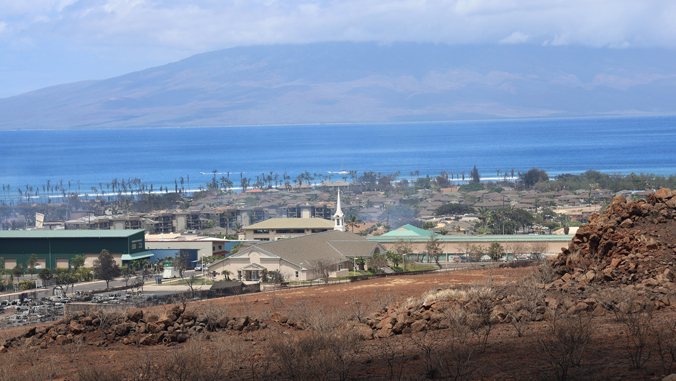
Health risks in the aftermath of the August 8 Maui wildfires were outlined by University of Hawaiʻi at Mānoa public health experts in a briefing for Hawaiʻi healthcare professionals. Catherine Pirkle and Rosana Hernandez Weldon of the Thompson School of Social Work & Public Health presented, “Environmental Health Impacts of the Maui Wildfires,” as part of an August 31 training webinar sponsored by the Hawaiʻi Public Health Institute.
“Given the unprecedented nature of the environmental health risks faced by those affected by the Maui wildfires, our aim was to address some questions that have been circulating in the community and in the media, particularly related to toxic compounds, and most importantly, help spread messaging from the health authorities about health advisories and how to protect oneself from potential exposures,” said Weldon, an associate specialist who’s research specializes in exposure assessment and environmental epidemiology of women, children and reproduction.
Pirkle, an associate professor and global health researcher trained in epidemiology and health services, said there is little to no precedent for a fire like the one in West Maui. “While there have been large urban fires in other locations, such as Paradise, California, few have been related to hurricanes. This is relatively a unique concern,” she said.
Examining key topics and preventing harm
Pirkle and Weldon provided an overview of basic environmental health topics, including how people are exposed to contaminants resulting from wildfires, populations who may be sensitive to health effects, and health concerns resulting from smoke, ash and water. These include, for example, human exposures to high levels of particulate matter, and to natural and manmade compounds such as heavy metals and volatile organic compounds.

- Populations at-risk: Pregnant women, children, older people, low-income people, people with existing health conditions, and those who are occupationally exposed, such as firefighters, are more at risk for developing health effects from environmental exposures related to the wildfires.
- Health effects: Very little is known about the health effects of exposure to chemical mixtures. Environmental exposures from the Maui wildfires are complex chemical mixtures.
- Comparisons to previous studies: Although health effects of each of the contaminants are discussed, some previous studies that showed these health effects may have been conducted with high, acute (short-term) exposures. The exposure scenario in Lahaina may be more long-term and low-dose depending on the contaminant. More will be known about the potential exposures as more sampling and analysis is conducted.
- Air monitoring/drinking water: Preliminary air monitoring and drinking water testing by the Hawaiʻi Department of Health (DOH) and the Environmental Protection Agency showed that air pollution from particulate matter was low, and volatile organic compounds were detected in only a few drinking water samples, which is encouraging news.
- Recommendations when entering burned areas: Individuals who plan to enter burned areas should protect themselves by wearing: a good fitting mask, preferably an N95-type mask; long sleeves; pants; socks; shoes; and gloves. Do not eat while in the impacted area, but be sure to stay hydrated. Minimize disturbing the ash that has settled on the ground so that it does not enter the air or nearby waters. To reduce the take-home pathway of exposure, people who enter the impacted area should change their clothing before returning to their family members who are advised against entering the impacted area.
Pirkle added, “The fire occurred in an area with nearshore tropical reefs. This is important for considering long-term environmental exposures to wildlife and people. There are important concerns about contaminants released by the fire entering the marine environment, including risks from recreational activities such as swimming to the consumption of contaminated fish.”
View Pirkle and Weldon’s presentation online. To learn the latest information on environmental health hazards and advisories related to the Maui wildfires, go to the DOH Maui Wildfire Response website.

